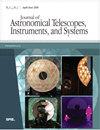设计和鉴定用于空间电子光学有效载荷的铝质可变形反射镜
IF 3.1
3区 工程技术
Q2 ENGINEERING, AEROSPACE
Journal of Astronomical Telescopes Instruments and Systems
Pub Date : 2024-07-01
DOI:10.1117/1.jatis.10.3.039002
引用次数: 0
摘要
可变形反射镜(DM)的目标是校正空间电子光学(EO)有效载荷中的畸变光波面。它是主动/自适应光学系统的一部分。基于金属的连续表面 DM 可靠性高,组装不复杂,有源表面的稳定性更好,成本较低,可以快速制造。此外,远离有源表面的金属 DM 使整体配置具有可扩展性。本研究延续了我们之前在可变形金属镜方面的工作,介绍了使用 25 个压电致动器的铝制 DM 的设计、验证和鉴定,其中包括位于镜面中心的致动器,以提高球差校正精度。此外,还介绍了可变形反射镜组件(DMA)的光学机械设计和性能及生存负载分析。随后,利用真空兼容闭环压电致动器建立了一个合格模型(QM)。通过校正反射镜本身的像差,证明了 QM 的校正精度。QM 在空间环境中的 ThermoVac 成功进行了测试,工作温度限制为 20°C±5°C,并证明了其在 20°C±40°C存储温度限制下的生存能力。同样,还证明了 QM 在正弦和随机振动负载等发射环境中的生存能力。所有这些测试的成功完成将该技术的成熟度提高到了 7 级技术就绪水平,现在可以为适当的星载 EO 有效载荷进行配置。本文章由计算机程序翻译,如有差异,请以英文原文为准。
Design and qualification of an aluminum deformable mirror for spaceborne electro-optical payloads
The goal of deformable mirrors (DMs) is to correct aberrated optical wavefronts in spaceborne electro-optical (EO) payloads. It is used as part of an active/adaptive optics system. A continuous-surface, metal-based DM is highly reliable and less complex to assemble, has better stability of the active surface, is less expensive, and can be manufactured quickly. In addition, metal DM with actuation away from the active surface makes the overall configuration scalable. Continuing our previous work on deformable metal mirrors, this work presents the design, validation, and qualification of an aluminum DM using 25 piezoelectric actuators, which include an actuator in the center of the mirror, to improve the spherical aberration correction accuracy. The optomechanical design and analysis of the deformable mirror assembly (DMA) are also presented for performance and survival loads. Later, a qualification model (QM) was built with vacuum-compatible closed-loop piezoelectric actuators. The correction accuracy was demonstrated at the QM by correcting aberrations in the mirror itself. The QM was successfully tested in the space environment in the ThermoVac for operating temperature limits of 20°C±5°C and demonstrated survivability for storage temperature limits of 20°C±40°C. Likewise, the survivability of QM for launch environments such as sinusoidal and random vibration loads is demonstrated. The successful completion of all these tests has improved the maturity of this technology to the technology readiness level of 7 and is now ready to be configured for the appropriate spaceborne EO payload.
求助全文
通过发布文献求助,成功后即可免费获取论文全文。
去求助
来源期刊

Journal of Astronomical Telescopes Instruments and Systems
Engineering-Mechanical Engineering
CiteScore
4.40
自引率
13.00%
发文量
119
期刊介绍:
The Journal of Astronomical Telescopes, Instruments, and Systems publishes peer-reviewed papers reporting on original research in the development, testing, and application of telescopes, instrumentation, techniques, and systems for ground- and space-based astronomy.
 求助内容:
求助内容: 应助结果提醒方式:
应助结果提醒方式:


